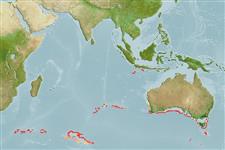Пластиножаберные (акулы и скаты) (sharks and rays) >
Carcharhiniformes (Ground sharks) >
Pentanchidae (Deepwater catsharks)
Etymology: Apristurus: a-, Latin privative, i.e., without; pristis, from pristes (Gr.), sawyer (but here meaning saw); oura (Gr.), tail, referring to absence of saw-toothed crest of enlarged dermal denticles along upper edge of caudal fin as found in the closely related Pristiurus (=Galeus). (See ETYFish); bucephalus: bu- (L.), prefix meaning large; cephalus, from kephale (Gr.), head, referring to its large, broad head. (See ETYFish).
More on authors: White, Last & Pogonoski.
Environment: milieu / climate zone / depth range / distribution range
экология
морской батидемерсальный; пределы глубины 1030 - 1140 m (Ref. 76944). Deep-water
Eastern Indian Ocean: Western Australia.
Size / Вес / Возраст
Maturity: Lm ? range ? - ? cm
Max length : 67.5 cm TL (female)
Краткое описание
морфология | морфометрия
This moderately-large species has the following characters: labial furrows of upper and lower subequal in length; relatively short preorbital snout; very robust head, its width (at mouth corners) 13.9% TL; large mouth, its width 11.1% TL; large orbit, its length 3.7% TL; relatively long length of prepectoral and prepelvic; first dorsal fin is slightly smaller than second one, its origin well forward of pelvic fin insertion; tall anal fin, short based, triangular in shape; widely spaced dermal denticles, moderately large, deciduous, with long medial cusps; species size to at least 67.5 cm TL; uniformly medium yellowish brown body and fins ; about 66 teeth rows in upper jaw, about 55 rows in lower jaw; adult female teeth with 5 cusps, 1 very long medial cusp, 2 much shorter inner lateral cusps, 2 much shorter outer lateral cusps situated anteriorly to inner lateral cusps; 35 monospondylous vertebrae; 26 diplospondylous precaudal vertebrae; about 108 total vertebrae (Ref. 76944).
Life cycle and mating behavior
половая зрелость | размножение | нерест | икра | Fecundity | личинки
White, W.T., P.R. Last and J.J. Pogonoski, 2008. Apristurus bucephalus sp. nov., a new deepwater catshark (Carcharhiniformes: Scyliorhinidae) from southwestern Australia. pp. 105-111. In P.R. Last, W.T. White and J.J. Pogonoski (eds). Descriptions of new Australian chondrichthyans. CSIRO Marine and Atmospheric Research Paper no. 22. 365 p. (Ref. 76944)
Статус Красного Списка МСОП (Ref. 130435)
Угроза для людей
Harmless
Использование человеком
дополнительная информация
народные названиясинонимыобмен веществхищникиэкотоксикологияразмножениеполовая зрелостьнерестSpawning aggregationFecundityикраРазвитие икры
Возраст/РазмерыростЗависимость между длиной и массой телаЗависимость между длинамиРазмерный составморфометрияморфологияличинкидинамика численности личинокпополнениечисленностьBRUVS
ссылкиаквакультура (рыбоводство)особенности рыбоводствастепень растяжениягенетикаElectrophoresesнаследуемостьболезниобработкаNutrientsMass conversion
соавторыизображенияStamps, Coins Misc.звукиCiguateraскоростьтип плаванияжаберная областьOtolithsмозгзрение
инструменты
Специальные отчеты
Скачать в формате XML
ресурсы в Интернет
Estimates based on models
Preferred temperature (Ref.
123201): 3.2 - 4.9, mean 4.4 °C (based on 17 cells).
Phylogenetic diversity index (Ref.
82804): PD
50 = 0.5000 [Uniqueness, from 0.5 = low to 2.0 = high].
Bayesian length-weight: a=0.00355 (0.00176 - 0.00714), b=3.09 (2.91 - 3.27), in cm total length, based on LWR estimates for this (Sub)family-body shape (Ref.
93245).
Trophic level (Ref.
69278): 3.9 ±0.4 se; based on size and trophs of closest relatives
устойчивость к внешним воздействиям (Ref.
120179): очень низкий, минимальное время удвоения популяции более 14 лет (Fec assumed to be < 10).
Fishing Vulnerability (Ref.
59153): Moderate to high vulnerability (47 of 100).
